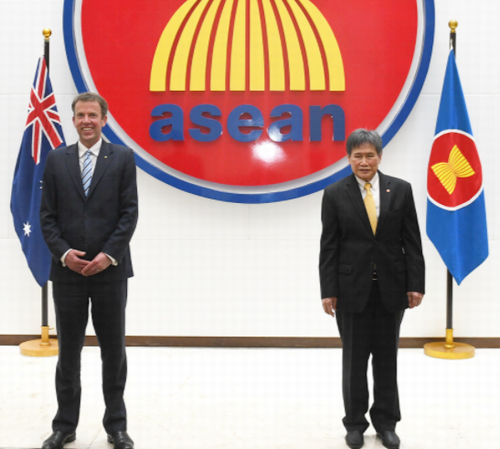
CANBERRA, Australia, January 4, 2022 (ENS) – The world’s largest free trade agreement, the Regional Comprehensive Economic Partnership Agreement, RCEP, entered into force on Saturday, January 1, giving 15 countries around the Pacific Rim access to trade with each other with fewer tariffs. Eventually, more than 90 percent of merchandise trade between approved RCEP member nations will be subject to zero tariffs.
According to the World Bank, the agreement covers 2.3 billion people accounting for US$25.8 trillion in output, as well as $12.7 trillion in trade.
The new trade agreement was signed November 15, 2020 and took effect for 10 of the signatory countries, including China, Japan, South Korea and Australia, on Saturday, the first day of 2022.
Australia’s Minister for Trade, Tourism and Investment Dan Tehan welcomed the RCEP’s entry into force for Australia, Brunei Darussalam, Cambodia, China, Japan, Laos, New Zealand, Singapore, Thailand, and Vietnam. South Korea will enter the agreement on February 1.
India withdrew from the RCEP talks in November 2019. There is a fast track accession process in place should India wish to re-join RCEP in future.
As for the remaining signatory States, the RCEP Agreement will enter into force 60 days after the deposit of their respective instruments of ratification, acceptance, or approval to the Secretary-General of ASEAN, the Association of Southeast Asian Nations.

Speaking for ASEAN, Secretary-General Dato Lim Jock Hoi said, the RCEP’s expeditious ratification process by its various members is “a true reflection of our strong commitment to a fair and open multilateral trading system for the benefit of the people in the region and the world.”
Minister Tehan said, “RCEP will help stimulate growth and investment across the region, providing increased opportunities for Australian business. With Australian-made products and services held in such high regard in these markets, RCEP is a fantastic opportunity for Australian businesses.”
“By streamlining requirements around rules of origin, RCEP will advantage local sourcing of goods and promote collaboration through regional value chains, which our businesses are primed to partake in,” Tehan said.
In the state-run Chinese news outlet Xinhua on January 1, writer Dong Yue elaborated, “The RCEP is expected to facilitate the building of an open global economy and strengthen globalization.”
“Distinct from the West-dominated globalization practices, in which drawbacks including a widening development divide and deficient global governance abound, the RCEP features remarkable openness and inclusiveness, providing an inspiration for future efforts to enrich economic globalization,” Dong wrote, indicating strong support of the agreement by China’s government.
“The pact covers a wide range of areas such as tariff reductions, trade facilitation and the opening-up of services and investment, while taking into account the diverse development stages and economic needs of each member, developed or developing,” explained Dong.
For China, the payoff is in the development, Dong wrote. The RCEP “will allow the region and the whole world to better share China’s development opportunities. After signing the agreement in 2020, China took the lead in ratifying the deal. In November 2021, China announced it has made every preparation to enforce the RCEP domestically and ensure all obligations are met.”
New Zealand Prime Minister Jacinda Ardern sees the deal as important to her country’s coronavirus recovery. “Securing free trade agreements like RCEP is an important part of New Zealand’s Trade Recovery Strategy, helping to put New Zealand in the best possible position to recover from the economic impacts of COVID-19 and seize new opportunities for exports and investment,” she said.
“A range of New Zealand industries will directly benefit from this new agreement, helping us to accelerate our economic recovery and build back better. These include the education sector, with new access opportunities into large ASEAN economies such as Indonesia, Thailand and the Philippines.
“Our primary industries will also profit – with the new expectation that Customs authorities will release perishable goods within six hours of arrival, helping to reduce spoilage and save money. And the meat industry specifically will benefit from the elimination of tariffs on some meat products into Indonesia.
“This free trade agreement also holds significant strategic value for New Zealand, by strengthening and deepening our relationships across the RCEP region,” Prime Minister Ardern said.
Australia sees great potential for development in the RCEP deal. Minister Tehan said, “RCEP also delivers a range of improvements over our existing trade agreements in areas where RCEP economies have the greatest growth potential, such as services, digital trade and two-way investment.”
RCEP will further strengthen Australia’s trade relationship with the Association of Southeast Asian Nations, ASEAN, at a crucial point in ASEAN’s economic development, Tehan said.
The RCEP pact is Japan’s first economic partnership agreement with China and South Korea, and it will benefit Australia, too, Tehan said. “International trade is integral to business recovery from COVID-19. The entry into force of RCEP and further tariff cuts through our other free trade agreements will help create Australian jobs and foster economic growth for our nation.”
“The RCEP has the potential to shape trade and investment patterns in Asia and the Pacific well into the future and to influence the direction of global economic cooperation at a challenging time,” the Asian Development Bank said in an October 2021 analysis. Results suggest that the RCEP could “generate sizable global income gains.” Together with the Comprehensive and Progressive Agreement on Trans-Pacific Partnership, it is expected to strengthen the region’s manufacturing supply chains, raising productivity and increasing wages and employment.
Featured image: A Hong Kong-flagged cargo ship heads for the Port of Singapore, June 5, 2019 (Photo by Thomas Timlen)



